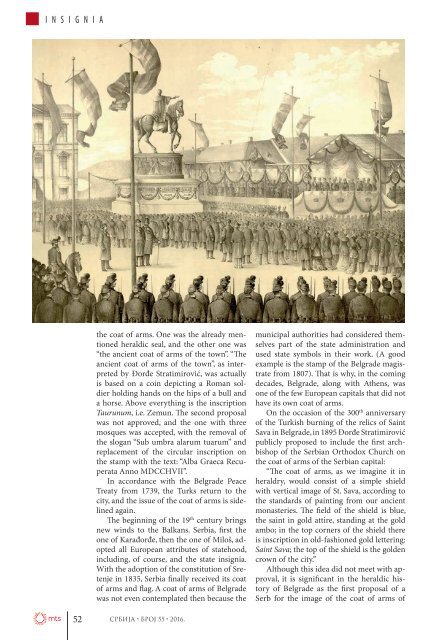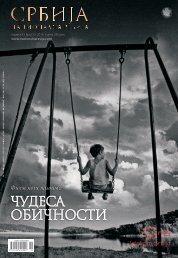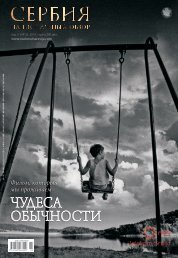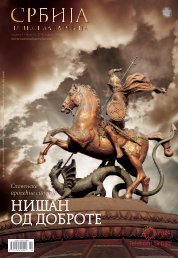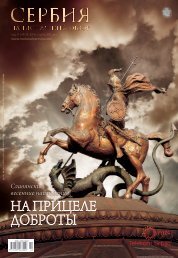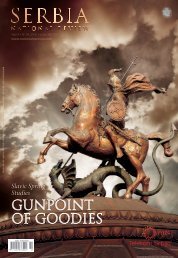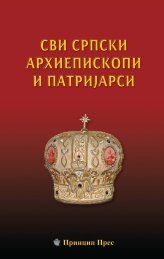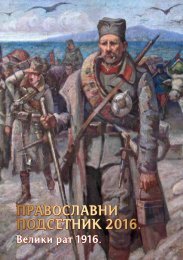Srbija - nacionalna revija - broj 55 - engleski - niska rezolucija
You also want an ePaper? Increase the reach of your titles
YUMPU automatically turns print PDFs into web optimized ePapers that Google loves.
I N S I G N I A<br />
the coat of arms. One was the already mentioned<br />
heraldic seal, and the other one was<br />
“the ancient coat of arms of the town”. “The<br />
ancient coat of arms of the town”, as interpreted<br />
by Đorđe Stratimirović, was actually<br />
is based on a coin depicting a Roman soldier<br />
holding hands on the hips of a bull and<br />
a horse. Above everything is the inscription<br />
Taurunum, i.e. Zemun. The second proposal<br />
was not approved, and the one with three<br />
mosques was accepted, with the removal of<br />
the slogan “Sub umbra alarum tuarum” and<br />
replacement of the circular inscription on<br />
the stamp with the text: “Alba Graeca Recuperata<br />
Anno MDCCHVII”.<br />
In accordance with the Belgrade Peace<br />
Treaty from 1739, the Turks return to the<br />
city, and the issue of the coat of arms is sidelined<br />
again.<br />
The beginning of the 19 th century brings<br />
new winds to the Balkans. Serbia, first the<br />
one of Karađorđe, then the one of Miloš, adopted<br />
all European attributes of statehood,<br />
including, of course, and the state insignia.<br />
With the adoption of the constitution of Sretenje<br />
in 1835, Serbia finally received its coat<br />
of arms and flag. A coat of arms of Belgrade<br />
was not even contemplated then because the<br />
municipal authorities had considered themselves<br />
part of the state administration and<br />
used state symbols in their work. (A good<br />
example is the stamp of the Belgrade magistrate<br />
from 1807). That is why, in the coming<br />
decades, Belgrade, along with Athens, was<br />
one of the few European capitals that did not<br />
have its own coat of arms.<br />
On the occasion of the 300 th anniversary<br />
of the Turkish burning of the relics of Saint<br />
Sava in Belgrade, in 1895 Đorđe Stratimirović<br />
publicly proposed to include the first archbishop<br />
of the Serbian Orthodox Church on<br />
the coat of arms of the Serbian capital:<br />
“The coat of arms, as we imagine it in<br />
heraldry, would consist of a simple shield<br />
with vertical image of St. Sava, according to<br />
the standards of painting from our ancient<br />
monasteries. The field of the shield is blue,<br />
the saint in gold attire, standing at the gold<br />
ambo; in the top corners of the shield there<br />
is inscription in old-fashioned gold lettering:<br />
Saint Sava; the top of the shield is the golden<br />
crown of the city.”<br />
Although this idea did not meet with approval,<br />
it is significant in the heraldic history<br />
of Belgrade as the first proposal of a<br />
Serb for the image of the coat of arms of<br />
52 SRBIJA • BROJ <strong>55</strong> • 2016.


